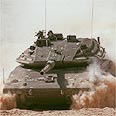
Why did Armored Corps fail in Lebanon?
Despite Merkava tank's rank of safest tank in the world, massive damage caused by antitank missiles. Armored Corps claims soldiers were not trained enough, basic tank gear missing
Fifty Israel Defense Forces tanks were damaged during the 34 day war in Lebanon, 30 soldiers and officers from the corps were killed and more than 100 were injured, including two battalion commanders. These are the statistics from the recent conflict.
Was it possible to have decreased the number of casualties? Subsequent investigations exposing details of earlier preparations underscore this question.
A senior defense establishment official told Ynet: "Some 350 to 400 tanks took part in the battles in Lebanon, and we can already posit that they stood against a few thousand antitank missiles, most of them with excellent penetration capacities."
According to the official, "it is possible to see from this that Hizbullah operatives were familiar with the tanks, their characteristics, they knew when and where to shoot in order to inflict the most damage."
Conditions in the armored corps prior to the war were not the best: many soldiers dealt with day-to-day security issues outside of the tanks, instead of undergoing significant field training in the tanks, similar to what they underwent in Lebanon.
Additionally, the corps did not receive top priority among senior defense establishment officials. Budget cuts took a heavy toll on armored units. According to the official, the armored vehicles were not used properly.
"In the battles in Lebanon, the tanks did not move and shoot. They remained 'static'. Instead of taking advantages of the tank's many capabilities, they underscored the tank's weakness, leading to heavy damages," said another senior official, who stated that the capabilities of the IDF's newest tank – the Merkava-4 – were barely utilized in the war.
"Our tanks are the most armored in the world, but there's no such thing as 100 percent protected. Only if you take advantage of their capabilities, can you ensure minimal damages," he explained.
The conditions for the armored corps were so harsh that the official referred to the tanks as "a person with one hand tied behind his back that turns his cheek to be slapped. Then people ask why he was hurt."
No budget, no smoke shield
Another depressing statistic: Twenty-two tanks sustained hits that penetrated their steal armor (in ten of the tanks, there were 23 fatalities; in the rest, severe damage was caused to the vehicle). Forty-four percents of the tanks hit by missiles had their armor penetrated. During the first Lebanon War, this happened to 47 percent of the tanks and in the Yom Kippur war, 60 percent.
In the last two days of the war, in the battles in Wadi Sluki and Marjayoun, 14 tanks were hit. The IDF decided that five of the tanks could not restore five of these tanks, two of which had been damaged by underbelly explosives (one of them a Merkava-4) and three of which had been demolished by antitank missiles.
In addition to cuts in the Armored Corps' procurement budget (down from NIS 1 billion to some NIS 750 million – about USD 170 million), many of the tank systems 'disappeared.' For example, the mortar shells field. The launching barrel remained, but no shells were purchased.
In addition, reserve soldiers called up to the war were astonished to discover that they are meant to enter Lebanon without a smoke shield in the tank. Shielding the area where the tank is stationed makes it possible to disguise it and prevent the enemy from firing on it. Due to the budgetary cuts, this option was prevented from the soldiers in the field.










